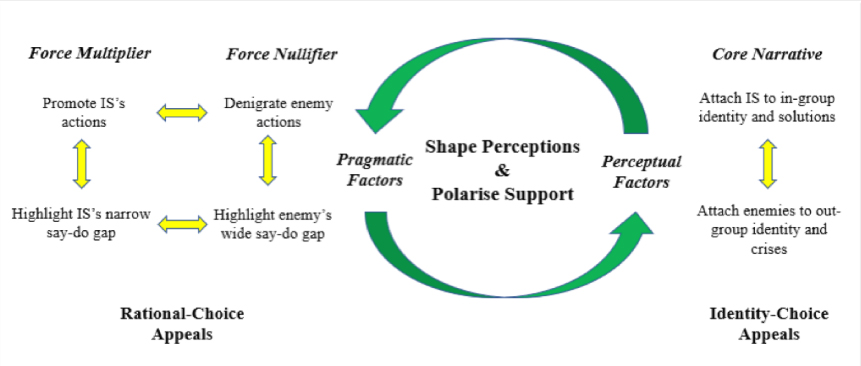In 2018, VOX-Pol published a total of 50 blog posts on the theme of Violent Online Political Extremism. The blogs covered topics as varied as crypocurrencies, human rights, propaganda, artificial intelligence, gender, social media, and data protection. A series of blog posts on ‘ethics in terrorism research’ was widely shared on Twitter, and an article surveying the alt-right in Europe was published in four European languages.
The blog continues to publish weekly articles HERE. Thank you for reading and sharing!
These are the top five most popular blog posts of 2018, by page views.
5. ‘Reverse-Engineering the ISIS Playbook, Part II: CT-CVE Messaging Lessons from ISIS’s English-Language Magazines’ by Haroro J. Ingram & Alastair Reed
Our fifth most read blog post of 2018 was part two of the two-part piece titled ‘Reverse-Engineering the ISIS Playbook’. The research described in this article seeks to demonstrate the utility of drawing upon primary source materials as a means to ‘reverse engineer’ lessons for CT-CVE strategic communications. Part II explores trends in the themes and propaganda strategies deployed in ISIS’ English-language magazines, and their implications for CT-CVE practitioners. It also considers the lessons for CT-CVE strategic communications.
Haroro J. Ingram is a senior research fellow with George Washington University’s Program on Extremism (Washington D.C.). Alastair Reed is the Director of the International Centre for Counter-Terrorism (The Hague). Both authors are researchers with the Counter-Terrorism Strategic Communications (CTSC) Project. Follow them on Twitter: @haroro_ingram; @reed_alastair; @CTSC_Project.
You can read the post HERE.
4. ‘The Islamic State’s Manipulation of Gender in their Online Information Operations’ by Kiriloi M. Ingram
This article introduces the debate around the Islamic State’s (IS’s) female combatants. It cuts through speculation and identifies four key trends in IS’s use of female archetypes. The article concludes that analysts should not overlook gender in IS propaganda, or be blinded by the peculiarity of female combatants. An important lesson can be learned: the potency of IS’s propaganda and its ability to mobilise and incite action from a male and female audience lies in its manipulation of constructed models of gender.
Kiriloi M. Ingram is a PhD candidate at the University of Queensland’s School of Political Science and International Studies. Her Twitter is @KiriloiIngram.
You can read the post HERE.

3. ‘Building Resilience for Terrorism Researchers’ by Peter King
This blog post was the most widely shared and read of the ‘ethics in terrorism research’ series. Author Peter King considers the effect that extremist propaganda is having on terrorism researchers, as images and videos have increased in volume and become more gory. King looks at a number of strategies for coping, including a few he and his colleagues have used, recognising that there is no single easy solution that works for everyone.
Peter King is an Arabic-speaking independent consultant who has been investigating the exploitation of the Internet by jihadist groups and their supporters for well over a decade. In 2004, he pioneered the systematic research and analysis of online jihadist media for the British government and went on to lead a dedicated team of experts in the field at the BBC.
You can read the post HERE.
2. ‘The Hidden Face of Hate Groups Online: A Former’s Perspective’ by Brad Galloway and Ryan Scrivens
In the summer of 2018, Brad Galloway, former right-wing extremist and now student at University of the Fraser Valley, attended the Terrorism and Social Media Conference hosted at Swansea University, where he presented a paper titled ‘The Hidden Face of Organized Hate Groups Online: A Former’s Perspective’. Drawing from his experience in Canada’s right-wing extremist movement, Galloway shed light on his online activities during his time in the movement, with a particular emphasis on how he – and others in organised hate groups – recruited people online. He also provided an inside look at the impact that the Internet had on the movement during his involvement. After the conference, VOX-Pol Visiting Researcher Ryan Scrivens caught up with Galloway to discuss some of the key takeaways from his presentation.
Brad Galloway is an undergraduate student in the School of Criminology and Criminal Justice at the University of the Fraser Valley. Ryan Scrivens is a Horizon Postdoctoral Fellow at Concordia University and a VOX-Pol alum. You can follow them on Twitter: @bjgalloway1717; @R_Scrivens.
You can read the post HERE.
1. ‘Reverse-Engineering the ISIS Playbook, Part I: CT-CVE Messaging Lessons from ISIS’s English-Language Magazines’ by Haroro J. Ingram & Alastair Reed
Our most widely read piece of the year was part one of a two-part post. In this article, Haroro J. Ingram and Alastair Reed present the key findings of the Counter-Terrorism Strategic Communications (CTSC) Project’s publication titled ‘Islamic State’s English-language Magazines, 2014-17: Trends & Implications for CT-CVE Strategic Communications’. The article begins by highlighting the limitations inherent to studies of ISIS’s English-language messaging before identifying the first of three key trends in the narratives, themes, and propaganda strategies deployed in ISIS’ English-language magazines, and their implications for CT-CVE practitioners.
Haroro J. Ingram is a senior research fellow with George Washington University’s Program on Extremism (Washington D.C.). Alastair Reed is the Director of the International Centre for Counter-Terrorism (The Hague). Both authors are researchers with the Counter-Terrorism Strategic Communications (CTSC) Project. Follow them on Twitter: @haroro_ingram; @reed_alastair; @CTSC_Project.
You can read the post HERE.
The strategic logic of IS Propaganda


